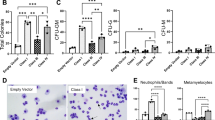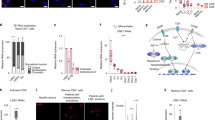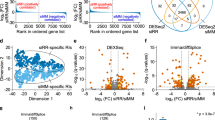Abstract
Alternative splicing results in multiple protein isoforms derived from a single gene. The magnitude of this process ranges from a complete loss of function to gain of new function. We examined, as a paradigm, alternative splicing of the non-redundant human cytokine, interleukin-7 (IL-7). We show that extensive IL-7 splicing in human tissues of different histology, including MTB+ granuloma lesions, transformed tissue and tumor cell lines. IL-7 splice variants were expressed as recombinant proteins. A differentially spliced IL-7 isoform, lacking exon 5, leads to STAT-5 phosphorylation in CD4+ and CD8+ T cells, promotes thymocyte maturation and T-cell survival. Human tumor lesions show aberrant IL-7 isoform expression, as compared with the autologous, non-transformed tissue. Alternatively spliced cytokines, such as IL-7, represent candidates for diagnostics and therapeutic interventions.
This is a preview of subscription content, access via your institution
Access options
Subscribe to this journal
Receive 6 digital issues and online access to articles
$119.00 per year
only $19.83 per issue
Buy this article
- Purchase on Springer Link
- Instant access to full article PDF
Prices may be subject to local taxes which are calculated during checkout






Similar content being viewed by others
References
Fry TJ, Mackall CL . The many faces of IL-7: from lymphopoiesis to peripheral T cell maintenance. J Immunol 2005; 174: 6571–6576.
Schluns KS, Kieper WC, Jameson SC, Lefrancois L . Interleukin-7 mediates the homeostasis of naive and memory CD8 T cells in vivo. Nat Immunol 2000; 1: 426–432.
Alpdogan O, Muriglan SJ, Eng JM, Willis LM, Greenberg AS, Kappel BJ et al. IL-7 enhances peripheral T cell reconstitution after allogeneic hematopoietic stem cell transplantation. J Clin Invest 2003; 112: 1095–1107.
Hartgring SA, Bijlsma JW, Lafeber FP, van Roon JA . Interleukin-7 induced immunopathology in arthritis. Ann Rheum Dis 2006; 65 (Suppl 3): iii69–iii74.
Roato I, Brunetti G, Gorassini E, Grano M, Colucci S, Bonello L et al. IL-7 up-regulates TNF-alpha-dependent osteoclastogenesis in patients affected by solid tumor. PLoS ONE 2006; 1: e124.
Rich BE, Campos-Torres J, Tepper RI, Moreadith RW, Leder P . Cutaneous lymphoproliferation and lymphomas in interleukin 7 transgenic mice. J Exp Med 1993; 177: 305–316.
Skjonsberg C, Erikstein BK, Smeland EB, Lie SO, Funderud S, Beiske K et al. Interleukin-7 differentiates a subgroup of acute lymphoblastic leukemias. Blood 1991; 77: 2445–2450.
Stamm S, Ben-Ari S, Rafalska I, Tang Y, Zhang Z, Toiber D et al. Function of alternative splicing. Gene 2005; 344: 1–20.
Matlin AJ, Clark F, Smith CW . Understanding alternative splicing: towards a cellular code. Nat Rev Mol Cell Biol 2005; 6: 386–398.
Goodwin RG, Lupton S, Schmierer A, Hjerrild KJ, Jerzy R, Clevenger W et al. Human interleukin 7: molecular cloning and growth factor activity on human and murine B-lineage cells. Proc Natl Acad Sci USA 1989; 86: 302–306.
Korte A, Moricke A, Beyermann B, Kochling J, Taube T, Kebelmann-Betzing C et al. Extensive alternative splicing of interleukin-7 in malignant hematopoietic cells: implication of distinct isoforms in modulating IL-7 activity. J Interferon Cytokine Res 1999; 19: 495–503.
Frishman J, Long B, Knospe W, Gregory S, Plate J . Genes for interleukin 7 are transcribed in leukemic cell subsets of individuals with chronic lymphocytic leukemia. J Exp Med 1993; 177: 955–964.
Madrigal-Estebas L, McManus R, Byrne B, Lynch S, Doherty DG, Kelleher D et al. Human small intestinal epithelial cells secrete interleukin-7 and differentially express two different interleukin-7 mRNA Transcripts: implications for extrathymic T-cell differentiation. Hum Immunol 1997; 58: 83–90.
Mire-Sluis AR, Healey L, Griffiths S, Hockley D, Thorpe R . Development of a continuous IL-7-dependent murine pre-B cell line PB-1 suitable for the biological characterisation and assay of human IL-7. J Immunol Methods 2000; 236: 71–76.
Garcia-Blanco MA . Messenger RNA reprogramming by spliceosome-mediated RNA trans-splicing. J Clin Invest 2003; 112: 474–480.
Tsytsikov VN, Yurovsky VV, Atamas SP, Alms WJ, White B . Identification and characterization of two alternative splice variants of human interleukin-2. J Biol Chem 1996; 271: 23055–23060.
Atamas SP, Choi J, Yurovsky VV, White B . An alternative splice variant of human IL-4, IL-4 delta 2, inhibits IL-4-stimulated T cell proliferation. J Immunol 1996; 156: 435–441.
Tan X, Lefrancois L . Novel IL-15 isoforms generated by alternative splicing are expressed in the intestinal epithelium. Genes Immun 2006; 7: 407–416.
Nishimura H, Fujimoto A, Tamura N, Yajima T, Wajjwalku W, Yoshikai Y . A novel autoregulatory mechanism for transcriptional activation of the IL-15 gene by a nonsecretable isoform of IL-15 generated by alternative splicing. FASEB J 2005; 19: 19–28.
Maeurer MJ, Walter W, Martin D, Zitvogel L, Elder E, Storkus W et al. Interleukin-7 (IL-7) in colorectal cancer: IL-7 is produced by tissues from colorectal cancer and promotes preferential expansion of tumour infiltrating lymphocytes. Scand J Immunol 1997; 45: 182–192.
Huang HW, Chiang YJ, Hung SI, Li CL, Yen JJ . An IL-7 splicing-defect lymphopenia mouse model revealed by genome-wide mutagenesis. J Biomed Sci 2007; 14: 169–181.
Cook RF, Cook SJ, Even DL, Schaffer C, Issel CJ . Full-length and internally deleted forms of interleukin-7 are present in horse (Equus caballus) lymph node tissue. Vet Immunol Immunopathol 2008; 125: 126–134.
Zhang Z, Duvefelt K, Svensson F, Masterman T, Jonasdottir G, Salter H et al. Two genes encoding immune-regulatory molecules (LAG3 and IL7R) confer susceptibility to multiple sclerosis. Genes Immun 2005; 6: 145–152.
Hafler DA, Compston A, Sawcer S, Lander ES, Daly MJ, De Jager PL et al. Risk alleles for multiple sclerosis identified by a genomewide study. N Engl J Med 2007; 357: 851–862.
Gregory SG, Schmidt S, Seth P, Oksenberg JR, Hart J, Prokop A et al. Interleukin 7 receptor alpha chain (IL7R) shows allelic and functional association with multiple sclerosis. Nat Genet 2007; 39: 1083–1091.
Lundmark F, Duvefelt K, Iacobaeus E, Kockum I, Wallstrom E, Khademi M et al. Variation in interleukin 7 receptor alpha chain (IL7R) influences risk of multiple sclerosis. Nat Genet 2007; 39: 1108–1113.
Resino S, Perez A, Leon JA, Gurbindo MD, Munoz-Fernandez MA . Interleukin-7 levels before highly active antiretroviral therapy may predict CD4+ T-cell recovery and virological failure in HIV-infected children. J Antimicrob Chemother 2006; 57: 798–800.
Lambeck AJ, Crijns AP, Leffers N, Sluiter WJ, ten Hoor KA, Braid M et al. Serum cytokine profiling as a diagnostic and prognostic tool in ovarian cancer: a potential role for interleukin 7. Clin Cancer Res 2007; 13: 2385–2391.
Al-Rawi MA, Mansel RE, Jiang WG . Interleukin-7 (IL-7) and IL-7 receptor (IL-7R) signalling complex in human solid tumours. Histol Histopathol 2003; 18: 911–923.
Al-Rawi MA, Rmali K, Mansel RE, Jiang WG . Interleukin 7 induces the growth of breast cancer cells through a wortmannin-sensitive pathway. Br J Surg 2004; 91: 61–68.
Pajares MJ, Ezponda T, Catena R, Calvo A, Pio R, Montuenga LM . Alternative splicing: an emerging topic in molecular and clinical oncology. Lancet Oncol 2007; 8: 349–357.
Gattinoni L, Finkelstein SE, Klebanoff CA, Antony PA, Palmer DC, Spiess PJ et al. Removal of homeostatic cytokine sinks by lymphodepletion enhances the efficacy of adoptively transferred tumor-specific CD8+ T cells. J Exp Med 2005; 202: 907–912.
Fry TJ, Mackall CL . Immune reconstitution following hematopoietic progenitor cell transplantation: challenges for the future. Bone Marrow Transplant 2005; 35 (Suppl 1): S53–S57.
Khong HT, Rosenberg SA . The Waardenburg syndrome type 4 gene, SOX10, is a novel tumor-associated antigen identified in a patient with a dramatic response to immunotherapy. Cancer Res 2002; 62: 3020–3023.
Conrad C, Vianna C, Freeman M, Davies P . A polymorphic gene nested within an intron of the tau gene: implications for Alzheimer's disease. Proc Natl Acad Sci USA 2002; 99: 7751–7756.
Acknowledgements
We thank Wolfgang Walter for screening cDNA for IL-7 transcripts and cloning, Professor Markus Heinemann, Department of Pediatric Cardiac Surgery, University of Mainz for provision of human thymic tissues, Professor E Jäger, Ludwig Institute for Cancer Research, Frankfurt, Germany for freshly harvested human tumor tissue and Professor H Pilch, Department of Gynecology, Mainz for analysis of tissue sections from patients with cervical cancer. Yen Ngo, MEB, Karolinska Institutet, Stockholm, Sweden for statistical analysis and Dr Sharon Kühlmann-Berenzon, SMI, Stockholm, Sweden for statistical advice. We are indebted to Professor Stoerkel and Dr Atkins, University of Wuppertal, Germany, for performing microdissection of thymic tissues. The study was supported by Karolinska Institutet and from a grant to MM from Cancerfonden, Sweden.
Author information
Authors and Affiliations
Corresponding author
Additional information
Supplementary Information accompanies the paper on Genes and Immunity website (http://www.nature.com/gene)
Rights and permissions
About this article
Cite this article
Vudattu, N., Magalhaes, I., Hoehn, H. et al. Expression analysis and functional activity of interleukin-7 splice variants. Genes Immun 10, 132–140 (2009). https://doi.org/10.1038/gene.2008.90
Received:
Revised:
Accepted:
Published:
Issue Date:
DOI: https://doi.org/10.1038/gene.2008.90
Keywords
This article is cited by
-
Nature of selection varies on different domains of IFI16-like PYHIN genes in ruminants
BMC Evolutionary Biology (2019)
-
Reduced plasma levels of soluble interleukin-7 receptor during graft-versus-host disease (GVHD) in children and adults
BMC Immunology (2014)
-
IL-7 splicing variant IL-7δ5 induces EMT and metastasis of human breast cancer cell lines MCF-7 and BT-20 through activation of PI3K/Akt pathway
Histochemistry and Cell Biology (2014)
-
Increased (6 exon) interleukin-7 production after M. tuberculosis infection and soluble interleukin-7 receptor expression in lung tissue
Genes & Immunity (2011)
-
Interleukin-7 (IL-7) and IL-7 splice variants affect differentiation of human neural progenitor cells
Genes & Immunity (2010)



